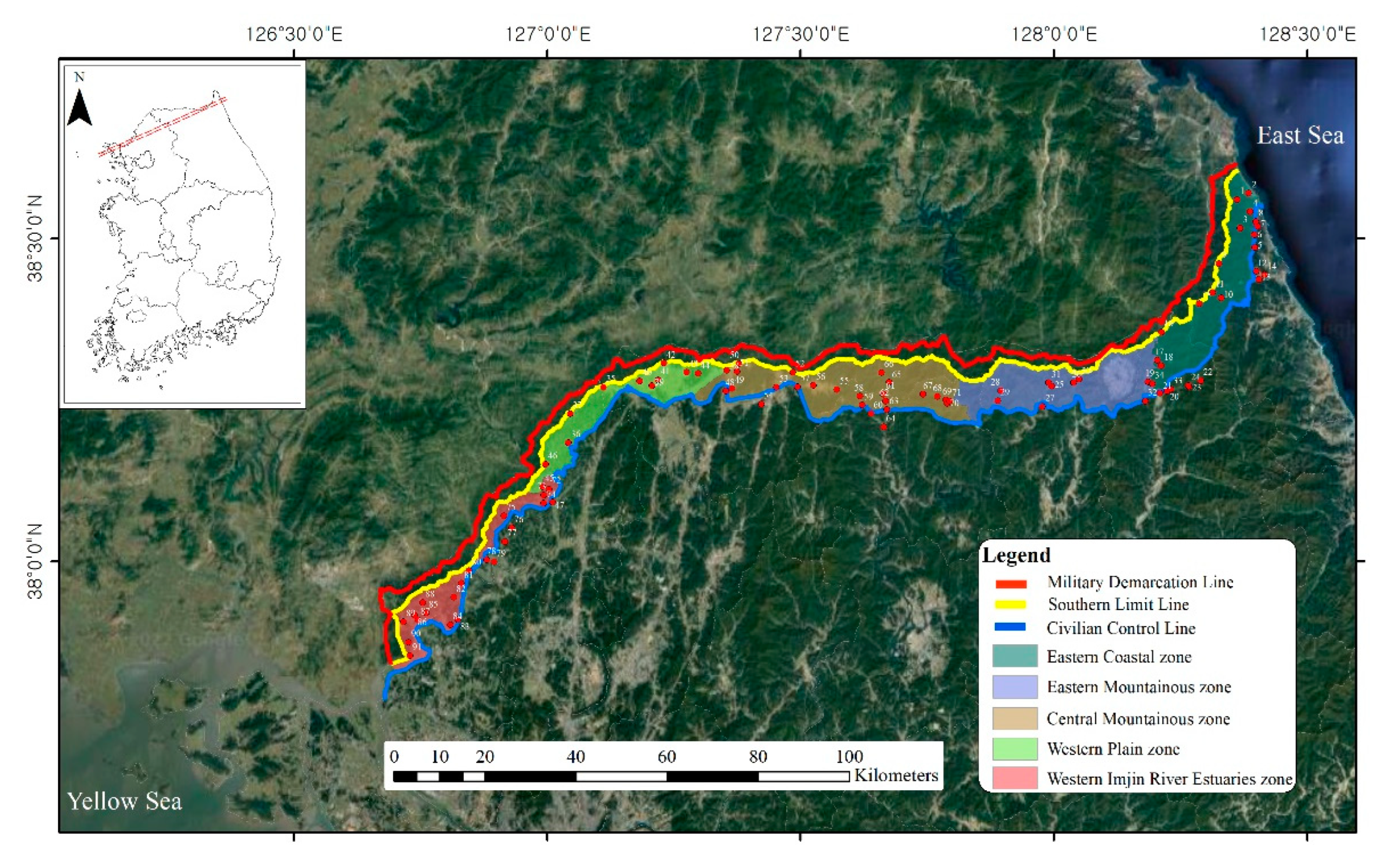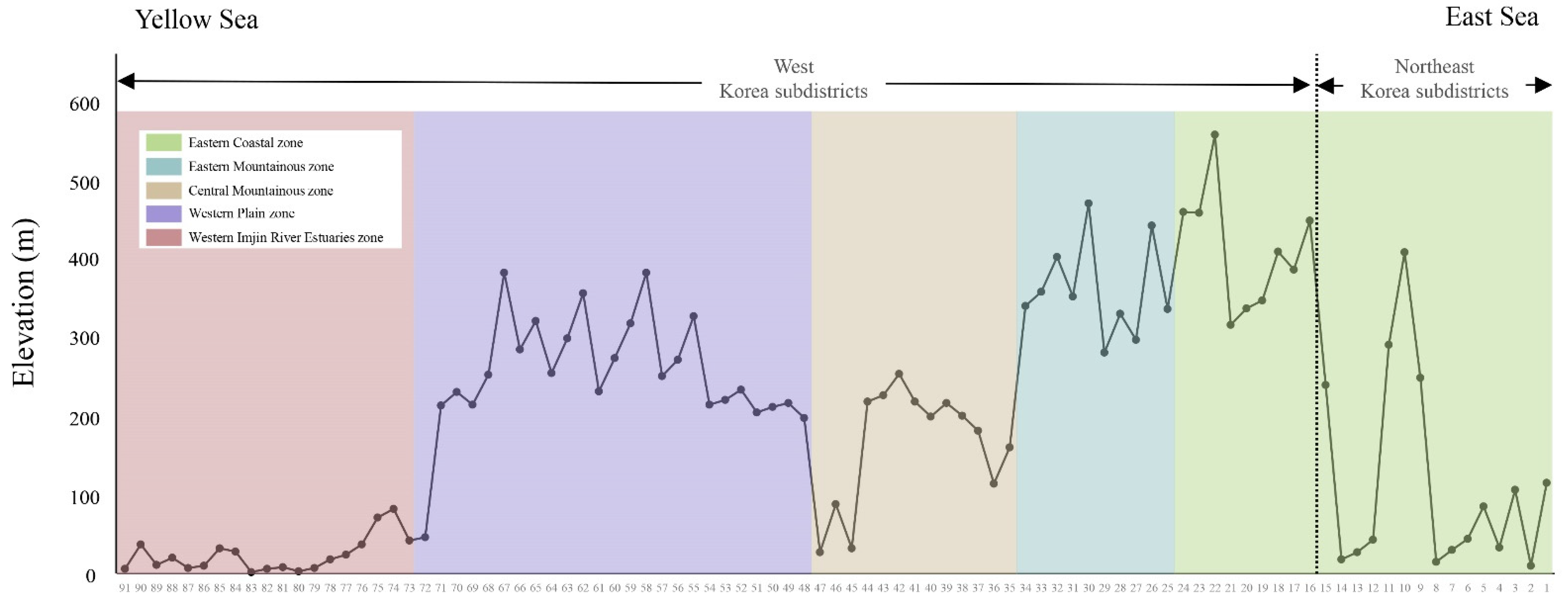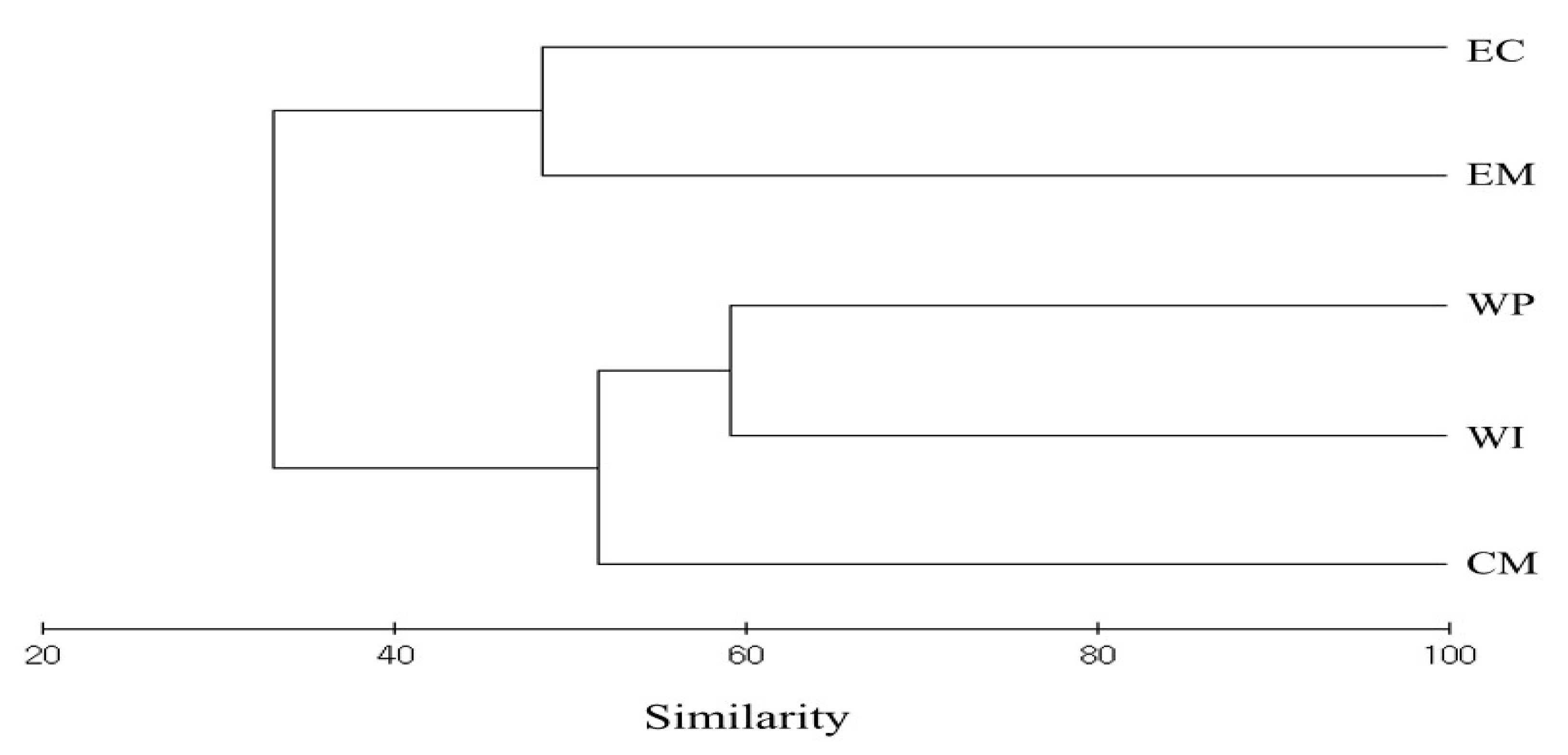Fish Diversity and Ichthyofauna of Areas Adjacent to the Demilitarized Zone in South Korea
Abstract
1. Introduction
2. Materials and Methods
2.1. Study Regions and Sites
2.2. Ichthyofauna Sampling and Geographic and Physical Surveys
2.3. Data Analysis
2.4. Human Activities and Disturbance
3. Results
3.1. Geographic and Physical Analysis
3.2. Fish Diversity and Fauna
3.3. Endemism
3.4. Human Activities and Disturbance
4. Discussion
4.1. Geographic Characteristics and Ichthyofauna
4.2. Endemism
4.3. Current Status and Conservation
Supplementary Materials
Author Contributions
Funding
Institutional Review Board Statement
Data Availability Statement
Acknowledgments
Conflicts of Interest
References
- John, K.H. The Korean DMZ: A fragile ecosystem. Science 1998, 280, 808–809. [Google Scholar] [CrossRef]
- Ministry of Environment (ME); National Institute of Ecology (NIE). Comprehensive Report on Biological Diversity in the DMZ Immediate Area; Korea Ministry of Environment: Gwacheon, Republic of Korea, 2016; 403p. (In Korean)
- Ministry of Culture and Public (MCP). Comprehensive Academic Survey Report on Adjacent Areas of DMZ; Ministry of Culture and Public: Daejeon, Republic of Korea, 1974; 316p. (In Korean)
- Ministry of Unification (MU). Amphibians, Reptiles and Fish in the Neighboring Area of the Korean DMZ; Korean Ministry 407 of Unification: Seoul, Republic of Korea, 1989; 72p. (In Korean)
- Cultural Heritage Administration (CHA). Report on Basic Resources of Natural Heritage in the Military Border Area (Central Region); Cultural Heritage Administration: Daejeon, Republic of Korea, 2005; 474p. (In Korean)
- Cultural Heritage Administration (CHA). Report on Basic Resources of Natural Heritage in the Military Border Area (Western Region); Cultural Heritage Administration: Daejeon, Republic of Korea, 2006; 467p. (In Korean)
- Cultural Heritage Administration (CHA). Report on Basic Resources of Natural Heritage in the Military Border Area (Eastern Region); Cultural Heritage Administration: Daejeon, Republic of Korea, 2007; 284p. (In Korean)
- Korea Forest Service (KFS). Comprehensive Report on Forest Ecosystem Inventory of DMZ and Border Areas (1995–2000); Korea Forest Service: Daejeon, Republic of Korea, 2000; 664p. (In Korean)
- Ministry of Environment (ME). Report of Detailed Survey on Nature Environment of the DMZ Immediate Area (I); Korea Ministry of Environment: Gwacheon, Republic of Korea, 1995; 560p. (In Korean)
- Ministry of Environment (ME). Ecosystem Approach for the Investigation, Analysis and Impact Assessment of De-Militarized Zone of Korea; Korea Ministry of Environment: Gwacheon, Republic of Korea, 2004; 603p. (In Korean)
- Ministry of Environment (ME); Korea Forest Service (KFS); Cultural Heritage of Administration (CHA). Research and Study Report on Ecology, Forest, and Cultural Property Current in the West Area of the DMZ; Korea Ministry of Environment, Korea Forest Service, Cultural Heritage of Administration: Daejeon, Republic of Korea, 2009; 314p. (In Korean)
- Ministry of Environment (ME). Report on Central DMZ Ecosystem; Korea Ministry of Environment: Gwacheon, Republic of Korea, 2010; 286p. (In Korean)
- Ministry of Environment (ME). Report on the DMZ Immediate Area Ecosystem (ecosystem survey in North Areas of the Civilian Control Line); Korea Ministry of Environment: Gwacheon, Republic of Korea, 2012; 296p. (In Korean)
- Ministry of Environment (ME). Report on the DMZ Immediate Area Ecosystem (Cenral Ecosystem Survey in North Areas of the Civilian Control Line); Korea Ministry of Environment: Gwacheon, Republic of Korea, 2013; 247p. (In Korean)
- Ministry of Environment (ME). Report on the DMZ Immediate Area Ecosystem (Western Ecosystem Survey in North Areas of the Civilian Control Line).; Korea Ministry of Environment: Gwacheon, Republic of Korea, 2014; 306p. (In Korean)
- National Institute of Ecology (NIE). Report on the DMZ Immediate Area Ecosystem (Eastern General Outpost Regions Ecosystem Survey in North Areas of the Civilian Control Line); Korea Ministry of Environment: Seocheon, Republic of Korea, 2014; 182p. (In Korean)
- National Institute of Ecology (NIE). Comprehensive Report on Biological Diversity in the DMZ Immediate Area; Korea Ministry of Environment: Seocheon, Republic of Korea, 2016; 403p. (In Korean)
- Mayr, E. Populations, Species, and Evolution: An Abridgment of Animal Species and Evolution; Belknap Press of Harvard University Press: Cambridge, MA, USA, 1969; 453p. [Google Scholar]
- Kim, I.S. Illustrated Encyclopedia of Fauna & Flora of Korea: Freshwater Fishes; Ministry of Education: Yeongi, Republic of Korea, 1997; Volume 37, 518p. (In Korean)
- Song, H.Y.; Kim, K.Y.; Yoon, M.K.; Nam, Y.K.; Kim, D.S.; Bang, I.C. Genetic variation of Coreoleuciscus splendidus populations (Teleostei: Cypriniformes) from four major river drainage systems in South Korea as assessed by AFLP markers. Genes Genomics 2010, 32, 199–205. [Google Scholar] [CrossRef]
- Cho, D.S. The ecological values of the Korean demilitarized zone (DMZ) and international natural protected areas. Korean J. Cult. Herit. Stud. 2019, 52, 272–287. (In Korean) [Google Scholar]
- Kani, T. Ecology of the Aquatic Insects Inhabiting a Mountain Stream. In Insects I; Furukawa, H., Ed.; Kenkyu-Sha: Tokyo, Japan, 1944; pp. 171–317. (In Japanese) [Google Scholar]
- Cummins, K.W. An evolution of some techniques for the collection and analysis of benthic samples with special emphasis on lotic waters. Amer. Mid. Nat. 1962, 67, 477–504. [Google Scholar] [CrossRef]
- National Institute of Environmental Research (NIER). Guidelines of National Natural Environment Survey (IV); National Institute of Environmental Research: Incheon, Republic of Korea, 2012; 490p. (In Korean)
- Kim, I.S.; Park, J.Y. Freshwater Fishes of Korea. Kyohak Publishing: Seoul, Republic of Korea, 2002; 467p. (In Korean) [Google Scholar]
- Kim, I.S.; Choi, Y.; Lee, C.L.; Lee, Y.J.; Kim, B.J.; Kim, J.H. Illusrated Book of Korea Fishes; Kyohak Publishing: Seoul, Republic of Korea, 2005; 615p. (In Korean) [Google Scholar]
- Nelson, J.S. Fishes of the World, 4th ed.; John Wiley & Sons, Inc.: Hoboken, NJ, USA, 2006; 601p. [Google Scholar]
- National Institute of Biological Resource (NIBR). National Species List of Korea, II: Vertebrates, Invertebrates, Protozoans; National Institute of Biological Resource: Incheon, Republic of Korea, 2019; 909p. (In Korean)
- Shannon, C.M. A mathematical theory of communication. Bell. Sys. Tech. J. 1948, 27, 379–423. [Google Scholar] [CrossRef]
- Margalef, R. Information theory in ecology. Gen. Syst. 1958, 3, 36–71. [Google Scholar]
- Pielou, E.C. Species-diversity and pattern diversity in the study of ecological succession. J. Theor. Biol. 1975, 10, 370–383. [Google Scholar] [CrossRef]
- McNaughton, S.J. Relationship among functional properties of California grassland. Nature 1967, 216, 168–169. [Google Scholar] [CrossRef]
- Jang, M.H.; Yoon, J.D.; Shin, J.H.; Joo, G.J. Status of freshwater fish around the Korean Demilitarized Zone and its implications for conservation. Aquatic. Conserv: Mar. Freshw. Ecosyst. 2008, 18, 819–828. [Google Scholar] [CrossRef]
- Choi, K.C. On the geographical distribution of freshwater fishes south of DMZ in Korea. Korean J. Limnol. 1973, 16, 1–8. (In Korean) [Google Scholar]
- Ko, M.H.; Ko, J.G.; Kim, H.S. Appearance patterns of freshwater fish in western DMZ adjacent areas, Gyeonggi-do, Korea. Korean Soc. Limnol. 2015, 48, 38–50. [Google Scholar] [CrossRef]
- Jung, S.W.; Kim, Y.H.; Kim, H.M.; Kim, S.H. Biodiversity and characteristic communities structure of freshwater ecosystems in the western area of DMZ, Korea. Korean J Environ. Ecol. 2019, 32, 603–617. [Google Scholar] [CrossRef]
- Lee, W.O.; Ko, M.H.; Bak, J.M.; Kim, D.H.; Jeon, H.J.; Kim, K.H. Characteristics of Fish Fauna and Community Structure in Buk Stream of Goseong, Korea. Korean J. Ichthyol. 2010, 22, 238–248. (In Korean) [Google Scholar]
- Sung, H.C.; Kim, S.R.; Kang, D.I.; Seok, J.Y.; Lee, S.M. Analysis on the type of damaged land in demilitarized zone (DMZ) area and restoration direction. J. Korean Env. Res. Tech. 2016, 19, 185–193. [Google Scholar] [CrossRef]
- Jang, M.H.; Lucas, M.C.; Joo, G.J. The fish fauna of mountain streams in South Korean national parks and its significance to conservation of regional freshwater fish biodiversity. Biol. Conser. 2003, 114, 115–126. [Google Scholar] [CrossRef]
- National Institute of Biological Resource (NIBR). Red Data Book of Republic of Korea: Freshwater Fishes; National Institute of Biological Resource: Incheon, Republic of Korea, 2019; Volume 3, 255p. (In Korean)
- Kim, J.D.; Kim, G.S. Experiment of the large mouth bass (Micropterus salmoides) transplantation (I) (Studies on the feed habit and growth). Bull. Nat. Fish. Hat. 1976, 1, 53–75. (In Korean) [Google Scholar]
- Son, Y.M.; Byeon, H.G. Feeding habit of main carnivorous fish (Erhthroculter erythropterus, Opsariichtys uncirostris and Micropterus salmoides) at Lake Paldang. Inst. Bas. Sci. Seowon Univ. 2001, 15, 61–78. (In Korean) [Google Scholar]
- Jang, M.H.; Kim, J.G.; Park, S.B.; Jeong, K.S.; Cho, G.I.; Joo, G.J. The current status of the distribution of introduced fish in large river systems of South Korea. Int. Rev. Hydrobiol. 2002, 87, 319–328. [Google Scholar] [CrossRef]
- Takaharu, N.; Takamura, N.; Nakagawa, M.; Kadono, Y.; Tanaka, T.; Mitsuhasi, H. Environmental and biotic characteristics to discriminate farm ponds with and without exotic largemouth bass and bluegill in western Japan. Limmology 2015, 16, 139–148. [Google Scholar] [CrossRef]
- Walsh, J.R.; Carpenter, S.R.; Zanden, M.J.V. Invasive species triggers a massive loss of ecosystem services through a trophic cascade. Proc. Natl. Acad. Sci. USA 2016, 113, 4081–4085. [Google Scholar] [CrossRef]
- Battisti, C.; Poeta, G.; Fanelli, G. An Introduction to Disturbance Ecology; Springer International Publishing: Cham, Switzerland, 2016; 187p. [Google Scholar]
- Westing, A.H. A transfrontier reserve for peace and nature on the Korean peninsula. Int. Environ. Affairs 1998, 10, 8–17. [Google Scholar]
- Oh, C.H.; Kim, Y.H.; Lee, H.Y.; Ban, S.H. The naturalization index of plant around abandoned military camps in civilian control zone. J. Korean Env. Res. Tech. 2009, 12, 59–76. (In Korean) [Google Scholar]
- Lee, S.H.; Lee, S.H.; Lee, S.A.; Choi, J.Y. Development of evaluation indices for ecological restoration of degraded environments near DMZ in the Republic of Korea. J. Korean Env. Res. Tech. 2015, 18, 135–151. [Google Scholar] [CrossRef][Green Version]
- Rieman, B.; Clayton, J. Wildfire and native fish: Issues of forest health and conservation of sensitive species. Fisheries 1997, 22, 6–15. [Google Scholar] [CrossRef]
- Rieman, B.; Lee, D.; Burns, D.; Gresswell, R.; Young, M.; Stowell, R.; Rhine, J.; Howell, P. Status of native fishes in the western United States and issues for fire and fuels management. For. Ecol. Manage. 2003, 178, 197–211. [Google Scholar] [CrossRef]
- Lee, C.H.; Shin, H.T.; Kwon, Y.H.; Yil, M.H.; Yoon, J.W.; Kim, G.S.; Park, G.H.; Sung, J.W. The Vascular Plant Species in the Korean Demilitarized zone (DMZ). J. Asia-Pacific Biodivers. 2013, 6, 31–81. [Google Scholar] [CrossRef][Green Version]
- Kim, S.T.; Jung, M.P.; Kim, H.S.; Shin, J.H.; Kim, J.H.; Kim, T.W.; Lee, J.H. Insect Fauna of Adjacent Areas of DMZ in Korea. J. Ecol. Field. Biol. 2006, 29, 125–141. [Google Scholar] [CrossRef]
- Kim, J.H.; Park, S.Y.; Kim, S.H.; Kang, K.W.; Waldman, B.; Lee, M.H.; Yu, M.H.; Yang, H.Y.; Chung, H.Y.; Lee, E.J. Structural implications of traditional agricultural landscapes on the functional diversity of birds near the Korean Demilitarized Zone. Ecol. Evol. 2020, 10, 12973–12982. [Google Scholar] [CrossRef]
- Gangwondo. Regional Resources Survey Report of near DMZ Area of Gangwondo Province; Kangwondo: Kangwondo, Republic of Korea, 1987; pp. 1–100. (In Korean)
- Gyeonggido. Regional Resources Survey Report of near DMZ Area of Kyonggido Province; Gyeonggido: Gyeonggido, Republic of Korea, 1987; pp. 1–100. (In Korean)
- Son, Y.M.; Jeon, S.R. Ichthyofauna on the DMZ ajacent areas in Goseonggun. J. Basic Sci. Res. (Seowon Univ.) 1991, 4, 33–49. (In Korean) [Google Scholar]
- Ministry of Environment (ME). Nature Ecosystem Survey Report on the DMZ Immediate Area; Korea Ministry of Environment: Gwacheon, Republic of Korea, 1992; 790p. (In Korean)
- Ministry of Environment (ME). Nature Ecosystem Survey Report on the DMZ Ajacent Areas (Goseonggun); Korea Ministry of Environment: Gwacheon, Republic of Korea, 2001; 141p. (In Korean)
- Ministry of Environment (ME). The 3rd Natural Environment Survey; Korea Ministry of Environment: Gwacheon, Republic of Korea, 2008. (In Korean)
- Ko, M.H.; Moon, S.J.; Bang, I.C. Fish Community Structure and Inhabiting Status of Endangered Species in Baebong Stream. Korean J. Ecol. Environ. 2013, 46, 192–204. [Google Scholar] [CrossRef]





| Index | WI * | WP | CM | EM | EC | Total |
|---|---|---|---|---|---|---|
| Order | 6 | 4 | 5 | 5 | 8 | 11 |
| Family | 14 | 10 | 12 | 8 | 13 | 19 |
| Genus | 45 | 33 | 31 | 16 | 31 | 56 |
| Species | 58 | 46 | 43 | 19 | 38 | 81 |
| Individuals | 4353 | 3405 | 7744 | 1516 | 2544 | 19,562 |
| Endangered species | 2 | 4 | 3 | 2 | 5 | 8 |
| Natural monument 1 | 1 | 1 | 1 | 1 | 1 | 1 |
| Endemic species | 18 | 20 | 20 | 13 | 17 | 29 |
| Red Data Book | 3 | 2 | 2 | 2 | 5 | 7 |
| Exotic species | 2 | 3 | 1 | 3 |
| Index | WI * | WP | CM | EM | EC |
|---|---|---|---|---|---|
| Diversity | 2.899 | 2.830 | 2.446 | 1.965 | 2.578 |
| Richness | 6.803 | 5.533 | 4.690 | 2.458 | 4.718 |
| Evenness | 0.714 | 0.739 | 0.650 | 0.667 | 0.709 |
| Dominance | 0.420 | 0.398 | 0.488 | 0.593 | 0.342 |
Publisher’s Note: MDPI stays neutral with regard to jurisdictional claims in published maps and institutional affiliations. |
© 2022 by the authors. Licensee MDPI, Basel, Switzerland. This article is an open access article distributed under the terms and conditions of the Creative Commons Attribution (CC BY) license (https://creativecommons.org/licenses/by/4.0/).
Share and Cite
Kim, H.; Seo, H.; Kim, S.; Kim, H.; Ko, M. Fish Diversity and Ichthyofauna of Areas Adjacent to the Demilitarized Zone in South Korea. Diversity 2022, 14, 1011. https://doi.org/10.3390/d14121011
Kim H, Seo H, Kim S, Kim H, Ko M. Fish Diversity and Ichthyofauna of Areas Adjacent to the Demilitarized Zone in South Korea. Diversity. 2022; 14(12):1011. https://doi.org/10.3390/d14121011
Chicago/Turabian StyleKim, Hyeongsu, Hyungsoo Seo, Suhwan Kim, Hyunmac Kim, and Myeonghun Ko. 2022. "Fish Diversity and Ichthyofauna of Areas Adjacent to the Demilitarized Zone in South Korea" Diversity 14, no. 12: 1011. https://doi.org/10.3390/d14121011
APA StyleKim, H., Seo, H., Kim, S., Kim, H., & Ko, M. (2022). Fish Diversity and Ichthyofauna of Areas Adjacent to the Demilitarized Zone in South Korea. Diversity, 14(12), 1011. https://doi.org/10.3390/d14121011







